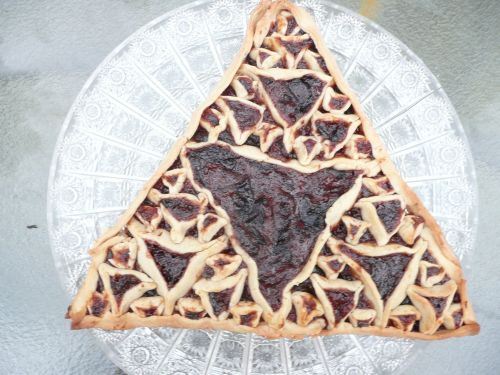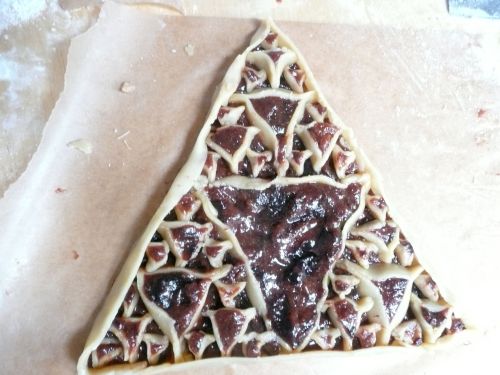It’s not often that you think you just did something nobody’s ever done before. But today, it might have happened.
It’s Purim, so I’m making the hamantaschen recipe my grandmother z”l developed while she was alive, and passed down to me. It’s my family obligation to make this recipe now every year and send hamantaschen out in boxes (gifts called mishloach manot) to my family and dear ones. I’ve done my best to preserve this recipe; I’ve written it up in the New York Times, I’ve taught workshops on how to make it for two Purims in a row, and I’ve committed to the family hamantaschen-baking role.
But this year, I did something else. You may be familiar with the Sierpinski triangle, a mathematically attractive, self-repeating fractal that starts with one equilateral triangle and breaks down into ever-smaller triangles.
Somehow this year it dawned on me that the world was incomplete without a Sierpinski hamantaschen, or sierpinskitaschen. I scoured the vast reaches of the Interwebs, to see if this had been done before. I may have missed something, but it seems this has not.
Until today.
Very carefully, I have made the possibly-world’s-first Sierpinskitaschen. It’s a little… irregular, but charmingly so. And it smells better than any Sierpinski triangle I’ve ever met.
Nerdecadent to be sure. Tessellicious, as my friend Ben said, although I’m pretty sure these are meant to be given away. And yes, ideas are already in the works for things like a mandelbrot, Mandelbrot set…
Now, just to be clear, I am not a mathemataschen, not by any stretch of the imagination. But I’ve been more and more inspired by math lately (details in a moment). I learned some basic facts about the Sierpinski triangle as i went. First of all, when rotated to any side, it looks the same; I couldn’t even tell where I’d started it. Also, as the triangles get smaller, notice a pattern in the quantity of each size: 1, 3, 9, 27…. I’m sure it would go on if I could make really really tiny hamantaschen, but I don’t have that much power. Also, technically this triangle has no area, so maybe all the sugar doesn’t count? But careful with that logic: it has infinite perimeter, and that dough for the perimeter is full of not-healthy ingredients like flour and sugar and oil.
Watch this stunning video lecture of my friend Dan teaching about the Sierpinski triangle. Watch the triangle grow out of a fractal line or Pascal’s triangle in really surprising ways, and try to guess how many dimensions the Sierpinski triangle has. (You will probably guess wrong, and that will be fun.)
There are many, many more cool things to learn about math and patterns and math and food. Dan from the video is my friend Dan Finkel, who writes www.mathforlove.com with his partner, mathematician Katherine Cook. It is their lovely blog that has inspired my appreciation for math and patterns and the overlap between math and the natural world, and math and playfulness/whimsy. At some less-busy moment in life, Dan is going to write a guest post for Seattle Local Food all about food and math. It’s not just about Romanesco cauliflower, though that’s a pretty cool place to start. In the meantime, check out their amazing blog. [Edited to add: The Sierpinskitaschen has been gifted to Dan and Katherine; they blogged about it here.]
~
You too can make this!
Sierpinski Hamantaschen
Start with my grandmother’s recipe. FYI, it’s not gluten-free (or paleo-friendly). Tomorrow I’m going to try a rice flour/tapioca version for myself, since I’ve been good and not eaten a single one of the hamantaschen I’m baking. Also, this is not a healthful recipe. It includes flour, sugar and oil, the trifecta I almost never eat. For the oil, I settle for high-oleic sunflower oil, since the high-oleic sutff is lower in omega-6 fatty acids.
Get yourself a dough scraper, about 5″ wide. You could do this with a knife too, but a dough scraper is a great tool to have around the kitchen for cleaning cutting boards, lifting fragile cookies, assembling hamantaschen, etc etc.
Roll out the dough and cut an equilateral triangle about 10″ on each side. Draw a line down the middle each way. Measure this carefully.
From strips of cut dough, make a triangle in the center, from the middle point of each triangle’s side. These dough strips will not want to stand up. So, use bits of aluminum foil to hold them in place. Quickly fill the center with prune butter.
Next, you’re making the three second-largest triangles. Take a glass about 3″ wide — to get the right measurement, hold it in the place where the next three large triangles will be and see if it fits perfectly. Follow grandma’s instructions for making those into hamantaschen. Place them, with one flat side up rather than one pointed side up (just like your big triangle).
Now, fill all open spaces with a thin layer of prune.
Now, find your next-smallest circle size, probably a little smaller than a shot glass. I used the top of a spice container. Make those into nine tiny hamantaschen, and place them into the fitting holes (consult a picture of the Sierpinski triangle as you do this). Finally, fill in the last spaces with 27 very tiny hamantaschen — I used the top of a bottle of vanilla extract.
Finally, time to make the sides. Roll out strips of dough and drape them around the sides and corners of the hamantaschen, letting them lean in a little.
Bake at 375 till golden brown at the edges.
And share, infinitely. Especially, but not exclusively, with Jewish math geeks.







